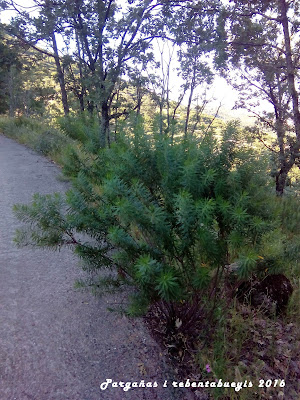Es ata agora el endilgu más compricau de sacal. Tó vinu, si vos acordais, de aquel día que anduvimus preguntandu pol nombri dela ardivieja, pos velallí al lau avía una mata dela Daphne gnidium. Dendi antoncis esta pranta muó comu tó ena naturaleza, maurandu siguiendu el ciclu del tiempu en baxu dun cielu que no perdona quien no lo sigui.
It is the most difficult article until now. Everything came from, if you remember, that day we where asking about the name of ardivieja, well, right beside it was Daphne gnidium. Since then, this common plant ripers according to the cycle of weather.
It is the most difficult article until now. Everything came from, if you remember, that day we where asking about the name of ardivieja, well, right beside it was Daphne gnidium. Since then, this common plant ripers according to the cycle of weather.
 |
| Torvisca con chinchi/Torvisca with a kind of bedbug |
Esta pranta, escrita, aborrá i vuelta a escrevil, acibi el nombri científicu del aurel (en griegu δάφνη), que mos recuerda ala istoria en que al dios Apolu en cata de Dafni l'estuvu un casu de trasformación. El apellíu vien por otru topónimu griegu Κνίδος, poli vieja dela Caria. En efetu, da un airi al aurel, peru comu vemus no es lo mesmu ni se puein confundil. Sin embargu, lo propius griegus lo travucavan con el olivu nanu, porque las ojas son mu aparecías, sigún mos cuenta Dioscóridis (IV 172).
This plant, written once and written again, has the scientific name of laurel (in Greek δάφνη), that remember us the story in which the god Apollo was pursuing Daphne and she turn into laurel. Its last name originates in another Greek place name called Κνίδος, an ancient Greek city-state from Caria. Indeed, it looks like laurel but as we can see it is neither the same nor they can be confused. Nevertheless, the own Greek people mixed it up with small olive, because its leaves are very similar, as stated by Dioscorides (IV 172).
 |
| Rama de torvisca ena primavera/Torvisca's branch in spring |
 |
| Mata de torvisca/Torvisca's plant |
Aquí llamamus esta pranta torvisca o torviscu, sigún los puebrus. El pie dela pranta tien el nombri de torvisquera i ondi ain muchas es un torviscal. En Estremaúra, esta pranta siempri á síu bien conocía delos pastoris i ombris de campu contra las pulgas. La corteza sirvi pa trençal i hazel correas por sel mu lástica. Amás esta corteza es conocía por sel un purganti potenti. Pal ombri esta pranta es envenenosa, prencipalmenti el frutu. Comu el varbascu, esta pranta sirvi pa encocal. Los antiguus gastavan delas ojas secas i tritulás o cozías, siempri en compaña d'otrus alimentus por causa dela su tossicidá. El bagu que crían, junta las froris, es verdi alo primeru i alogu se vá pusiendu colorau, destacandu-si bastanti entre'l ramagi, sigún vemus enas retrataúras.
We call this plant torvisca o torviscu, it depends on the village. The base of this plant is called torvisquera and as a whole it is called torviscal. In Estremadura, it has been always well known by the shepherds and the field workers for its use againts fleas. The bark serves as cords, for it is very flexible. Moreover, this bark is known as a strong purgative plant. For the human beings, it is toxic, mainly its fruit. Like varbascu, this plant serves to poison the water. The ancient people mashed the dry leaves and ground or boiled, and always accompanied them with some food due to its toxicity. The fruit and the flowers are green at first and then they turn into a reddish colour, standing out among the branches, as we see in the pictures.
 |
| Rama con froris i hormigas/Branch with flowers and ants |
La torvisca es pranta de monti i barrancas i la encontramus en sitius bravíus i ala sombra de enzinas o roblis que las protegi contra las pelonas i o el solatu. Es corrienti vel por estas fechas la mata dela pranta con froris i los frutus a maural, coloreandu i atrayendu bichinus a çugal del necta.
The torvisca is located in the hills and ravines. We can also find it at the foot of holm oaks and oaks where they are protected from freeze and the ray of sunlight. It is very common to see in these dates the plant with the flowers and fruits ripering, colouring and attracting bugs to suck its nectar.
 |
| Detalli dela pranta con froris i un frutu/ Detail of the plant with its flowers and fruits |
DATUS DELA PRANTA/PLANT'S DATA
Nombri científicu/Scientific name: Daphne gnidium
Nombri corrienti/Common name: Torvisca, tolvisca, torviscu, toroviscu, chorviscu.
Familia/Family: Thymelaeaceae
Floración/Flowering period: Juniu-otubri/June-October
A TENTU DELAS RETRATAÚRAS/ABOUT PICTURES
Sitiu/Place: El Conventu, Garganta la Lus (Cabeçuela/Cabezuela del Valle), Garganta las Casillas (Nava'l-Conceju/Navaconcejo).
Fecha dela retrataúra/Picture's date: 14/09/16 (1, 4, 5); 05/06/16 (2, 3).
Máquina de retratal/Camera: Aquaris E4.5, ALE L21.
BIBLIOGRAFÍA/BIBLIOGRAPHY
ATILLUS/LINKS- Dioscórides. Plantas y remedios medicinales, trans. Valdés García, Manuela. Gredos, Madrid, 1982. Print.
- Charco, Jesús, et al. Árboles y arbustos autóctonos de Extremadura. CIAMED: Ciudad Real, 2008. Print.









